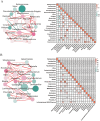Endometrial microbiome during early pregnancy among women with and without chronic endometritis: a pilot study
- PMID: 40880628
- PMCID: PMC12380780
- DOI: 10.3389/fcimb.2025.1615182
Endometrial microbiome during early pregnancy among women with and without chronic endometritis: a pilot study
Abstract
Introduction: Although chronic endometritis (CE) is strongly associated with infertility and adverse pregnancy outcomes, the specific microbiome of women with CE who can conceive remain unclear.
Methods: This study recruited 100 participants aged 18 to 45 years with spontaneously conceived pregnancy who opted for pregnancy termination, detected their endometrial microbiome by 16S rRNA, and made a diagnosis of CE.
Results: Among them, 19 were diagnosed with CE. There was a comparable microbial composition within the endometrium between women with and without CE. The relative abundance of Sphingomonas (21%) and Pseudomonas (8%) were the same in both groups. Compared to women without CE, women with CE exhibited higher abundance of Faecalibacterium (6.5% vs 3.8%), Escherichia-Shigella (3.3% vs 2.6%), Akkermansia (1.65% vs 1.1%), and lower abundance of Lactobacillus (10% vs 14%), and Corynebacterium (1.35% vs 2.15%) at the genus level. Streptococcus, Escherichia-Shigella, Akkermansia and Finegoldia exhibited significant interactions with other microbiome in participants with CE.
Discussion: In women with CE, reproductive potential may be associated with the compositional stability of the endometrial microbiome, whereas an imbalance in the abundance of these microbes may be linked to their pregnancy outcomes.
Keywords: 16S rRNA; chronic endometritis; early pregnancy; endometrial microbiome; host factors.
Copyright © 2025 Gao, Lu, Chen, Li, Li, Chen, Black, Gale, Corsi, Wang, Connor and Wen.
Conflict of interest statement
The authors declare that the research was conducted in the absence of any commercial or financial relationships that could be construed as a potential conflict of interest.
Figures





References
-
- Anderson M. J. (2008). A new method for non-parametric multivariate analysis of variance. Austral Ecology. 26, 32–46. doi: 10.1046/j.1442-9993.2001.01070.x - DOI
-
- Brown R. G., Al-Memar M., Marchesi J. R., Lee Y. S., Smith A., Chan D., et al. (2019). Establishment of vaginal microbiota composition in early pregnancy and its association with subsequent preterm prelabor rupture of the fetal membranes. Transl. Res. May 207, 30–43. doi: 10.1016/j.trsl.2018.12.005, PMID: - DOI - PMC - PubMed
MeSH terms
Substances
LinkOut - more resources
Full Text Sources

